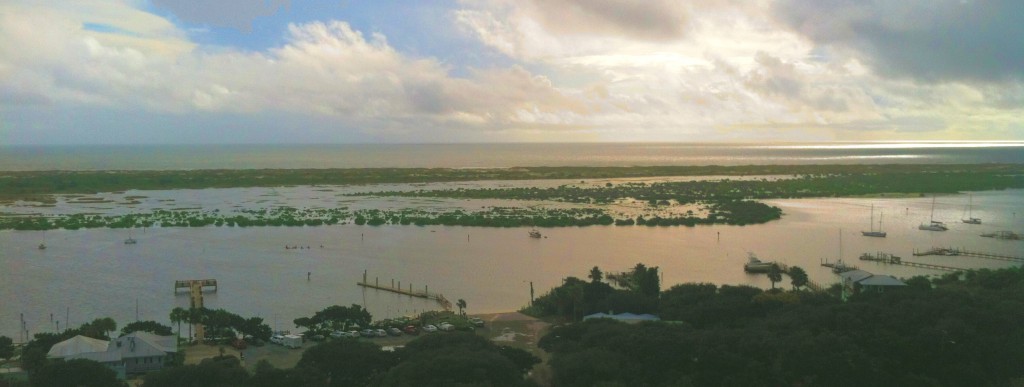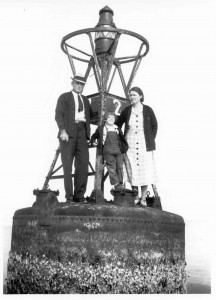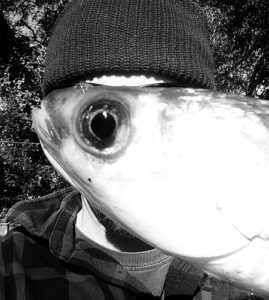Autumn brings the smell of wood smoke, washed sunlight, and relief from the oven of summer. Around St. Augustine, wood smoke as often indicates a backyard campfire as someone smoking fish. Mullet are on the beach, we’ve had our first fall Nor’easter, and all seems to be about right here in the Ancient City.

Fall brings high tides every year, but 2015 has been exceptional. Check out this picture taken at high tide on the 27th of September, the day of the super moon.
October is a big month for the St. Augustine Lighthouse, it’s our birthday.
On the evening of October 15, 1874 Keeper William Russell lit the wick in the new lighthouse, transferring the flame from the old Spanish tower.

Lighthouse Keeper Cardell Daniels seen here in January of 1936. While this was taken in the winter, the fall is time for nor’easters and buoys to go adrift.
Every storm since then has battered the structure with wind and caked the ironwork with salt. For about 50,000 days, the sun has worn down the paint with its rays. The lighthouse has been viewed through a U-boat’s periscope, shot in more recent times, even attacked by a tiger. But it is still here, as much a part of the community as pirlau, smoked mullet, and the Datil pepper. Not only is it here, but the old gal looks as good as ever!
Fall is a time for fat white shrimp, caught here for over a century and served to the world. It is a time for migrating flocks of birds, seen in vee’s overhead, often flying down the beach. It is a time for the garden to come back to life. Seen from the observation deck, osprey swoop to rise with clutched fish, sailboats plunge out the inlet into the Atlantic, and puffy summer cumulus clouds transition to the usual winter stratus. It’s a time for higher high tides, for big redfish, and easy parking downtown (for a little while). Fall is a time too, for oyster roasts. The lighthouse stands in the middle of this world, a gentle swarm of humanity and nature.
Here at the museum, our research transitions from the field to the lab.
After three months of diving, surveying, and excavating, our archaeology team is drying out for a spell. We are often asked ‘so what do you do when you aren’t diving?’ Good question. Fueling a boat, buying and maintaining gear, paying salaries, and funding the myriad other expenses incurred by a research program takes a major funding effort.
During the fall, winter and spring we write grants, manage active grants, seek private financial contributions, even do some contract work to help make ends meet.
Funding aside, research and conservation takes up the bulk of our time. The Storm Wreck is by no means our only research project.
Chuck Meide, Director of the Museum’s research arm, the Lighthouse Archaeological Maritime Program (LAMP), works to manage the program and make sure all of the ‘I’s have dots and the ‘T’s get crossed. He also is principle author on our research reports, written for each field season and sometimes going for several hundred pages. Recently, he published a peer-reviewed article in the International Journal of Nautical Archaeology about vernacular watercraft.
Dr. Sam Turner works on early colonial Spanish documents to piece together our earliest history and manages the heritage boatworks.
Olivia McDaniel, staff archaeologist, keeps track of LOTS of data, ranging from diving statistics to grant accounting. She also contributes to field reports, artifact research, and gives tours each day to explain our program to guests.
Our conservation team, Starr Cox, Andrew Thomson, and Maggie Burkett are the are still processing artifacts to bring them back to life from a 240 year old slumber. What they can do with a seemingly boring piece of rust is simply amazing.

This time of year is the time of the mullet, a mainstay of refined palates (mine included, of course) along the First Coast for thousands of years.
Finally, I work with oral histories of our commercial fishing and boatbuilding past, am presently working on an economic study of St. Augustine’s boatbuilding industry, just finished producing the 2nd printing of Shrimp Boat City, analyze magnetic and acoustic data, and give a fair number of presentations around the region and state about our work.
All of the above people mentioned thus far, including myself, couldn’t do their jobs without our dedicated team of volunteers. They are as much our colleagues as they are family and our eternal thanks goes out to them.
And so a new research season is in full swing. While the wetsuits dry out, the gear is re-stowed, we continue the discovery process and you are always welcome to come join us!
Join us online, join us on-site, and join me this coming October 29th at 6:30 p.m. at the St. Augustine Distillery for a book signing of Shrimp Boat City!
Brendan Burke joined the St. Augustine Lighthouse & Maritime Museum in 2007 as an archaeologist for the Lighthouse Archaeological Maritime Program. He holds a graduate degree in Anthropology from the College of William & Mary.

